Numerical Simulation Analysis of the Impact of Urbanization on an Extreme Precipitation Event over Beijing–Tianjin–Hebei, China
Abstract
1. Introduction
2. Data and Methods
2.1. Case Selection
2.2. Model Description and Experimental Design
3. Results
3.1. Simulated Precipitation
3.2. Simulation Results Analysis
4. Potential Physical Mechanisms of Urban Expansion Affecting Precipitation
5. Conclusions
- (1)
- In the early stage of urbanization of the BTH region, the temperature increase of about 1.5 °C caused by the urban heat island effect enhanced vertical motion; the increase in surface roughness caused the wind to converge, further enhancing the instability of the atmosphere, and the increase in surface sensible heat flux was conducive to the occurrence of convection. These urbanization effects increased the precipitation in urban and downstream areas, and especially in the suburbs. It can be seen that, in the eastern part of Beijing and the western side of Tianjin, the average hourly precipitation increased by 6–10 mm. Therefore, in the early stage of urbanization, the urban heat island effect played a leading role in precipitation.
- (2)
- With the further development of urbanization, especially the expansion of Beijing and Tianjin and the formation of urban agglomerations, the water storage capacity of the vegetation and soil was hindered, resulting in an urban dry island effect. The reduction of surface evapotranspiration, the increase in the boundary layer height, and the increase in the turbulent flux over the city made the stratification of the lower troposphere water vapor more uniform. The reduction of water in the central city has the potential to inhibit the development of convection and even precipitation, which may offset the positive impact of the heat island effect. The simulation comparison also reveals that the urban precipitation in Beijing was not further enhanced after the further expansion of the urban underlying surface, but an increased range of 8–10 mm was noted.
- (3)
- There was a good positive correlation between the area of the urban region and the duration of heavy precipitation. That is, after the expansion of the underlying surface of Beijing and Tianjin, the northwest dry cold airflow and the eastern sea wind front water vapor transport were delayed. This delay caused the precipitation system to move more slowly in urban areas, which led to an increase in the duration of heavy precipitation in Beijing and Tianjin from four to six hours.
- (4)
- A vertical uplift area caused by the simultaneous expansion of Beijing and Tianjin appeared between the adjacent suburbs of the two major cities. The urban underlying surface of the adjacent cities jointly affected the distribution of vertical motion. The vertical movement areas of the adjacent areas of Beijing and Tianjin were superimposed, and the vertical ascending motion was enhanced, resulting in an increase in precipitation in the area.
6. Discussion
- Using the latest multilayer urban canopy model, we explored the effects of different stages in the process of urbanization on precipitation, and the mutual influence between neighboring large cities after the formation of urban agglomerations.
- The impact of urbanization after westerly air flow over the mountains was a focus. Urbanization has a more obvious impact on the advancement of cold and warm air. Tianjin is close to Bohai Bay, where heavy rains are significantly affected by sea breeze fronts. The analysis of the impact of urbanization was based on the impact of sea breeze fronts on the transport of water vapor to land. It was found that the city had an obvious blocking effect, slowing down the precipitation system and resulting in a longer precipitation duration.
Author Contributions
Funding
Acknowledgments
Conflicts of Interest
References
- Zhang, W.L.; Cui, X.P. Main progress of torrential rain researches in North China during the past 50 years. Torrential Rain Disasters 2012, 31, 384–391. (In Chinese) [Google Scholar]
- Horton, R.E. Thunderstorm-breeding spots. Mon. Weather Rev. 1921, 49, 193–206. [Google Scholar] [CrossRef]
- Shepherd, J.M. A review of current investigations of urban-induced rainfall and recommendations for the future. Earth Interact. 2005, 9, 1–27. [Google Scholar] [CrossRef]
- Huff, F.A.; Changnon, S.A.J. Precipitation Modification by Major Urban Areas. Bull. Am. Meteorol. Soc. 2010, 54, 1220–1233. [Google Scholar] [CrossRef]
- Changnon, S.A. Rainfall changes in summer caused by st. Louis. Scinece 1979, 205, 402–404. [Google Scholar] [CrossRef] [PubMed]
- Shepherd, J.M.; Pierce, H.; Negri, A.J. Rainfall modification by major urban areas: Observations from spaceborne rain radar on the TRMM satellite. J. Appl. Meteorol. 2012, 41, 689–701. [Google Scholar] [CrossRef]
- Shepherd, J.M.; Burian, S.J. Detection of Urban-Induced Rainfall Anomalies in a Major Coastal City. Earth Interact. 2003, 7, 1. [Google Scholar] [CrossRef]
- Bornstein, R.; Lin, Q. Urban heat islands and summertime convective thunderstorms in Atlanta: Three cases studies. Atmos. Environ. 2000, 34, 507–516. [Google Scholar] [CrossRef]
- Kishtawal, C.M.; Niyogi, D.; Tewari, M.; Pielke Sr, R.A.; Shepherd, J.M. Urbanization signature in the observed heavy rainfall climatology over India. Int. J. Climatol. 2010, 30, 1908–1916. [Google Scholar] [CrossRef]
- Li, W.; Chen, G.; Chen, W.; Sha, W.; Luo, C.; Feng, Y.; Wen, Z.; Wang, B. Urbanization signatures in strong versus weak precipitation over the Pearl River Delta metropolitan regions of China. Environ. Res. Lett. 2011, 6, 049503. [Google Scholar] [CrossRef]
- Mitra, C.; Shepherd, J.M.; Jordan, T. On the relationship between the premonsoonal rainfall climatology and urban land cover dynamics in Kolkata city, India. Int. J. Climatol. 2012, 32, 1443–1454. [Google Scholar] [CrossRef]
- Steiger, S.M.; Orville, R.E. Cloud-to-ground lighting enhancement over southern Louisiana. Geophys. Res. Lett. 2003, 30, 1975. [Google Scholar] [CrossRef]
- Inoue, T.; Kimura, F. Numerical experiments on fair-weather clouds forming over the urban area in northern Tokyo. SOLA 2007, 3, 125–128. [Google Scholar] [CrossRef][Green Version]
- Shem, W.; Shepherd, M. On the impact of urbanization on summertime thunderstorms in Atlanta: Two numerical model case studies. Atmos. Res. 2009, 92, 172–189. [Google Scholar] [CrossRef]
- Lin, C.Y.; Chen, W.C.; Chang, P.L.; Sheng, F.Y. Impact of the urban heat island effect on precipitation over a complex geographic environment in northern Taiwan. J. Appl. Meteorol. Climatol. 2011, 50, 339–353. [Google Scholar] [CrossRef]
- Liu, S.H.; Liu, Z.X.; Zheng, H.; Miao, Y.; Chen, B.; Wang, S.; Zhao, J.; Li, Y.; Zheng, Y.; Guo, L. Multi-scale atmospheric boundary-layer and land surface physics process models. Sci. Sin. Phys. Mech. Astron. 2013, 43, 1332–1355. (In Chinese) [Google Scholar] [CrossRef]
- Liu, S.H.; Liu, Z.X.; Li, J.; Wang, Y.; Ma, Y.; Sheng, L.; Liu, H.; Liang, F.; Xin, G.; Wang, J. Numerical Simulation of Atmospheric Local Circulation Coupling Effect in Beijing-Tianjin-Hebei Region. Sci. China Ser. D 2009, 39, 88–98. (In Chinese) [Google Scholar]
- Liu, K.; Li, X.; Wang, S.; Li, Y. Investigating the impacts of driving factors on urban heat islands in southern China from 2003 to 2015. J. Clean. Prod. 2020, 254, 120141. [Google Scholar] [CrossRef]
- Oke, T.R. The energetic basis of the urban heat island, Q.J.R. Meteorol. Soc. 1982, 108, 1–24. [Google Scholar]
- Shepherd, J.M.; Carter, W.M.; Manyin, M.; Messen, D.; Burian, S. The impact of urbanization on current and future coastal precipitation: A case study for Houston. Environ. Plann. 2010, 37, 284–304. [Google Scholar] [CrossRef]
- Thielen, J.; Wobrock, W.; Gadian, A.; Mestayer, P.G.; Creutin, J.D. The possible influence of urban surfaces on rainfall development: A sensitivity study in 2D in the meso-gamma scale. Atmos. Res. 2000, 54, 15–39. [Google Scholar] [CrossRef]
- Lin, C.Y.; Chen, W.C.; Liu, S.C.; Liou, Y.A.; Liu, G.R.; Lin, T.H. Numerical study of the impact of urbanization on the precipitation over Taiwan. Atmos. Environ. 2008, 42, 2934–2947. [Google Scholar] [CrossRef]
- Miao, S.; Chen, F.; Li, Q.; Fan, S. Impacts of urban processes and urbanization on summer precipitation: A case study of heavy rainfall in Beijing on 1 August 2006. J. Appl. Meteorol. Climatol. 2011, 50, 806–825. [Google Scholar] [CrossRef]
- Yoshikado, H. Interaction of the sea breeze with urban heat islands of different sizes and locations. J. Meteorol. Soc. Jpn. 1994, 72, 139–142. [Google Scholar] [CrossRef]
- Carter, M.; Shepherd, J.M.; Burian, S.; Jeyachandran, I. Integration of lidar data into a coupled mesoscale-land surface model: A theoretical assessment of sensitivity of urban-coastal mesoscale circulations to urban canopy parameters. J. Atmos. Ocean. Technol. 2012, 29, 328–346. [Google Scholar] [CrossRef]
- Niyogi, D.; Pyle, P.; Lei, M.; Arya, S.P.; Kishtawal, C.M.; Shepherd, M.; Chen, F.; Wolfe, B. Urban modification of thunderstorms: An observational storm climatology and model case study for the Indianapolis urban region. J. Appl. Meteorol. Climatol. 2011, 50, 1129–1144. [Google Scholar] [CrossRef]
- Kaufmann, R.K.; Seto, K.C.; Schneider, A.; Liu, Z.; Zhou, L.; Wang, W. Climate response to rapid urban growth: Evidence of a human-induced precipitation deficit. J. Clim. 2007, 20, 2299–2306. [Google Scholar] [CrossRef]
- Guo, X.L.; Fu, D.H.; Wang, J. Mesoscale convective precipitation system modified by urbanization in Beijing City. Atmos. Res. 2006, 82, 112–126. [Google Scholar] [CrossRef]
- Zhang, C.L.; Chen, F.; Miao, S.G.; Li, Q.C.; Xia, X.A.; Xuan, C.Y. Impacts of urban expansion and future green planting on summer precipitation in the Beijing metropolitan area. J. Geophys. Res. 2009, 114, D02116. [Google Scholar] [CrossRef]
- Georgescu, M.; Mahalov, A.; Moustaoui, M. Seasonal hydroclimatic impacts of Sun Corridor expansion. Environ. Res. Lett. 2012, 7, 034026. [Google Scholar] [CrossRef]
- Wang, J.; Feng, F.; Yan, Z.; Hu, Y.; Jia, G. Nested high-resolution modeling of the impact of urbanization on regional climate in three vast urban agglomerations in China. J. Geophys. Res. 2012, 117, D21103. [Google Scholar] [CrossRef]
- Kusaka, H.; Kondo, H.; Kikegawa, Y.; Kimura, F. A simple single-layer urban canopy model for atmospheric models: Comparison with multi-layer and slab models. Bound. Lay. Meteorol. 2001, 101, 329–358. [Google Scholar] [CrossRef]
- Kusaka, H.; Kimura, F. Coupling a single-layer urban canopy model with a simple atmospheric model: Impact on urban heat island simulation for an idealized case. J. Meteorol. Soc. Jpn. Ser. II 2004, 82, 67–80. [Google Scholar] [CrossRef]
- Wang, Y.; Wu, W.; Zhu, B. Performance comparison pf different urban canopy schemes in WRF model under Chongqing meteorological simulation. Resour. Environ. Yangtze Basin 2013, 22, 1627. (In Chinese) [Google Scholar]
- Tao, S.Y. Heavy Rainstorm in China; Beijing Science Press: Beijing, China, 1980; pp. 1–71. (In Chinese) [Google Scholar]
- Zhang, J.; Zhou, Y.S.; Shen, X.Y.; Li, X.F. Evolution of dynamic and termal structure and instability condition analysis of extreme precipitation system in Beijing-Tianjin-Hebei on 19 July 2016. Chin. J. Atmos. Sci. 2019, 43, 930–942. (In Chinese) [Google Scholar]
- Broxton, P.D.; Zeng, X.; Sulla-Menashe, D.; Troch, P.A. A Global Land Cover Climatology Using MODIS Data. J. Appl. Meteorol. Clim. 2014, 53, 1593–1605. [Google Scholar] [CrossRef]
- Kain, J.S. The Kain-Fritsch convective parameterization: An update. J. Appl. Meteorol. 2004, 43, 170–181. [Google Scholar] [CrossRef]
- Bougeault, P.; Lacarrere, P. Parameterization of orography-induced turbulence in a mesobeta-scale model. Mon. Weather Rev. 1989, 117, 1872–1890. [Google Scholar] [CrossRef]
- Chen, F.; Dudhia, J. Coupling an Advanced Land Surface Hydrology Model with the Penn State NCAR MM5 Modeling System. Part I: Model Implementation and Sensitivity. Mon. Weather Rev. 2001, 129, 569–585. [Google Scholar] [CrossRef]
- Martilli, A.; Clappier, A.; Rotach, M.W. An Urban Surface Exchange Parameterisation for Mesoscale Models. Bound. Lay. Meteorol. 2002, 104, 261–304. [Google Scholar] [CrossRef]
- Wang, J.; Feng, J.; Yan, Z. Potential sensitivity of warm season precipitation to urbanization extents: Modeling study in Beijing-Tianjin-Hebei urban agglomeration in China. J. Geophys. Res. Atmos. 2015, 120, 9408–9425. [Google Scholar] [CrossRef]
- Liu, K.; Su, H.; Li, X. Comparative assessment of two vegetation fractional cover estimating methods and their impacts on modeling urban latent heat flux using Landsat imagery. Remote Sens. 2017, 9, 455. [Google Scholar] [CrossRef]
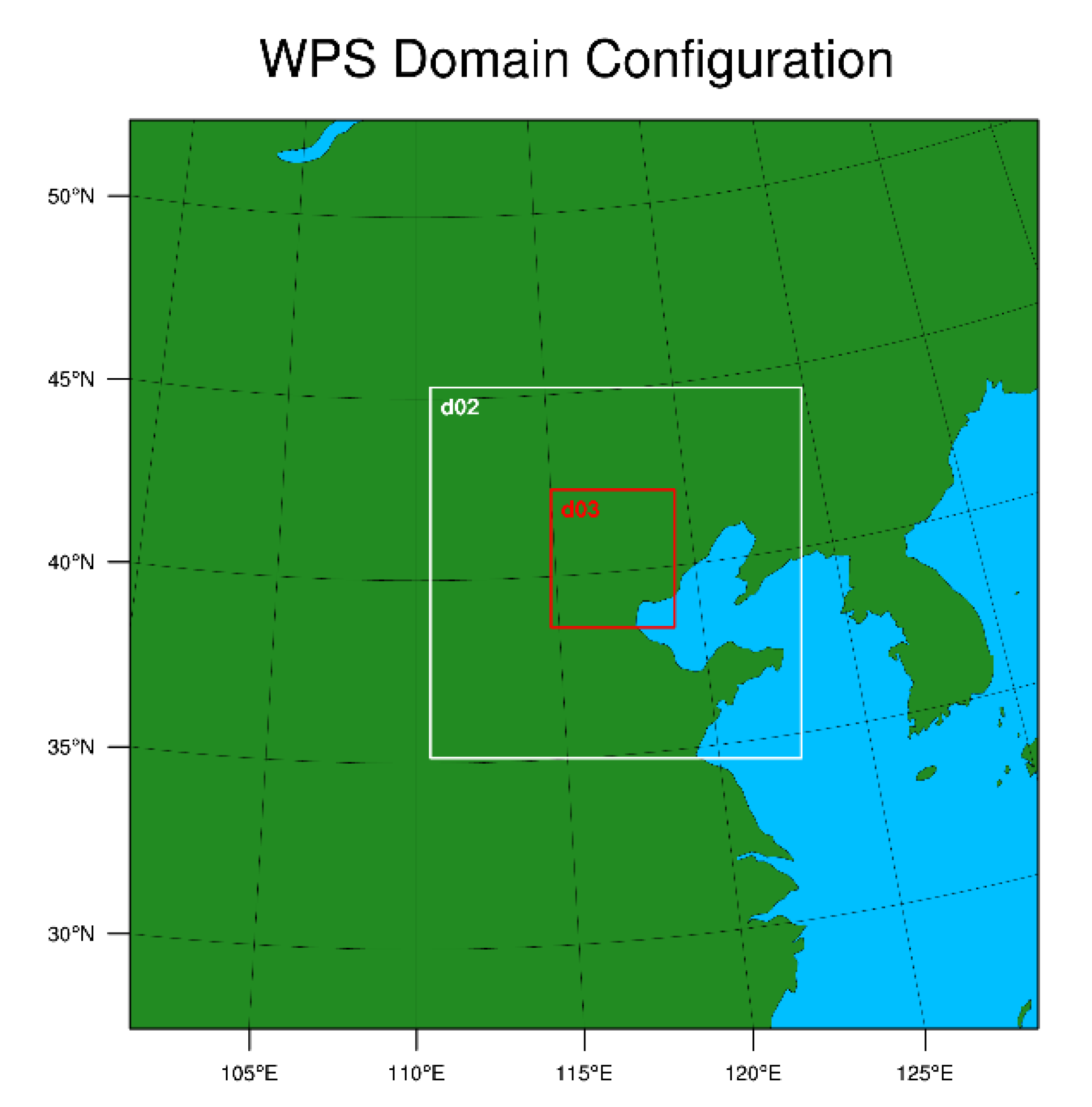


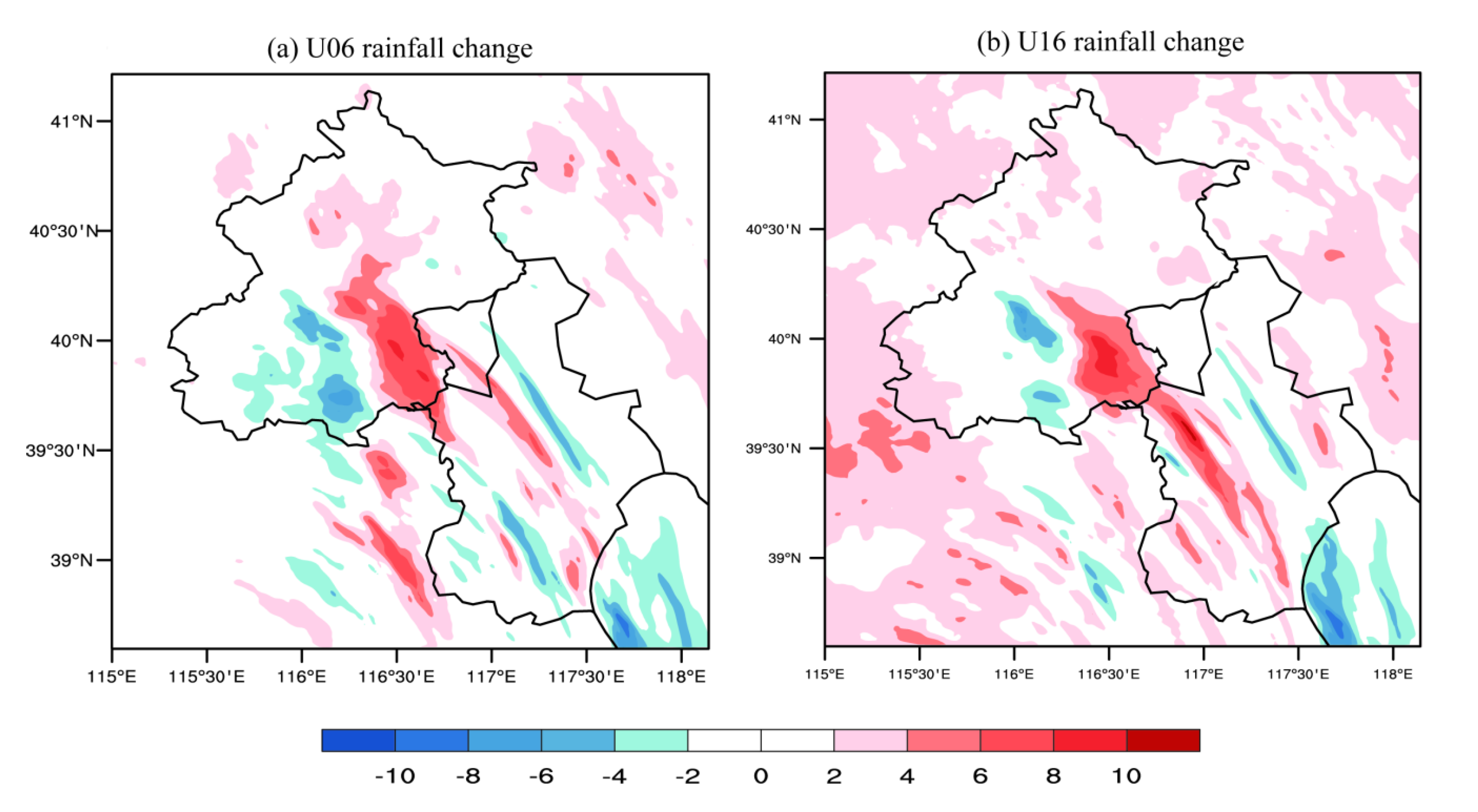
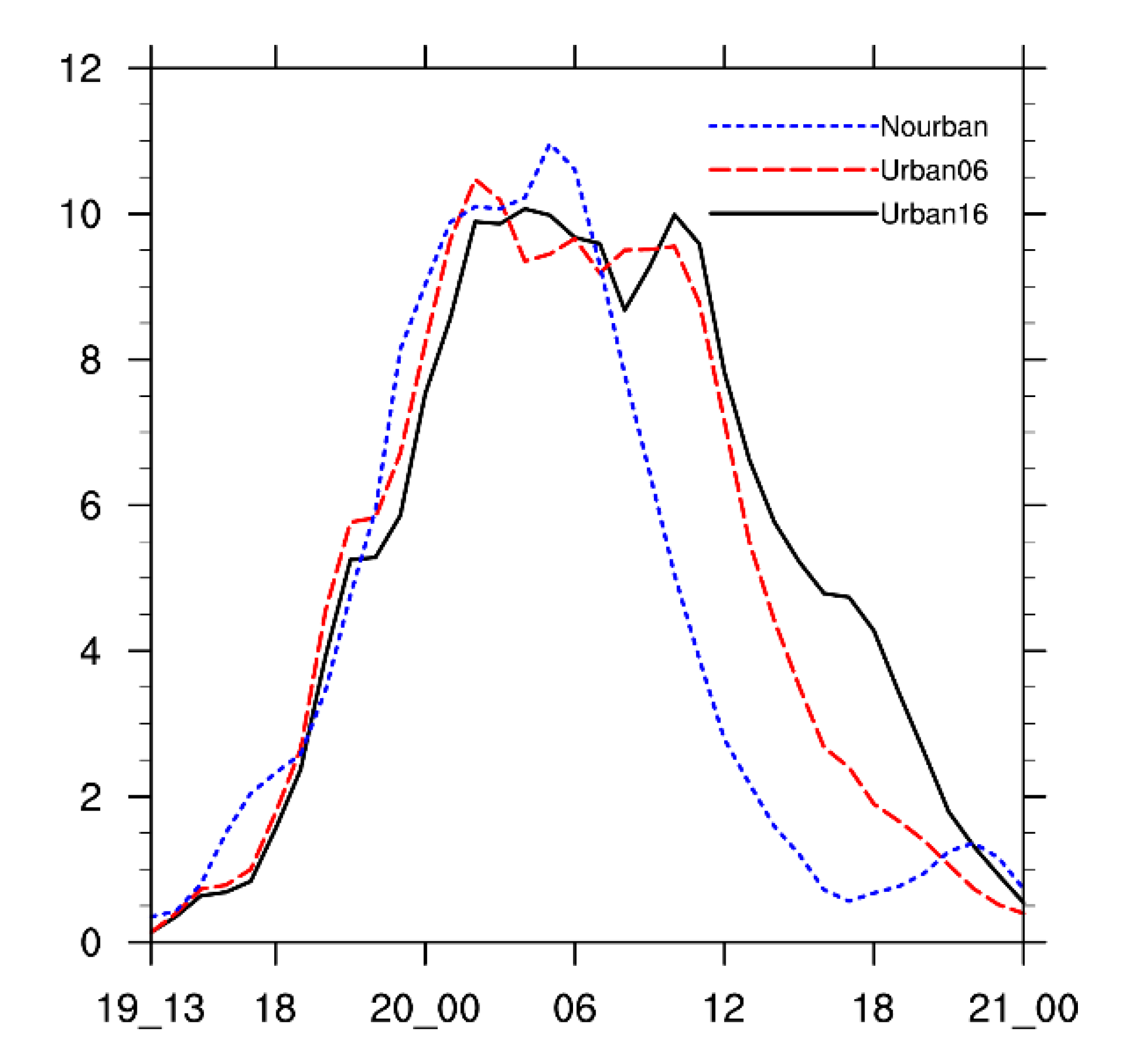
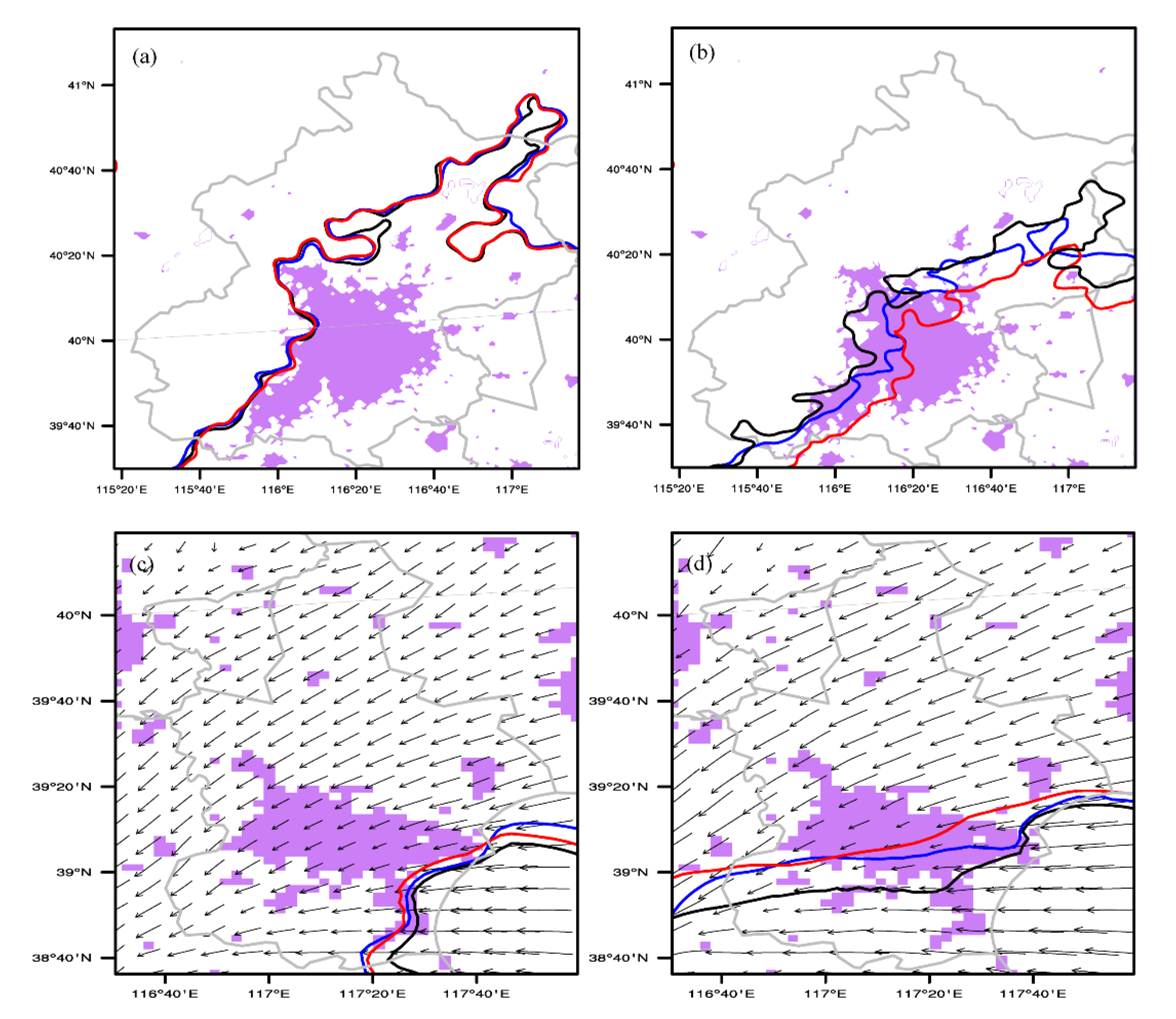
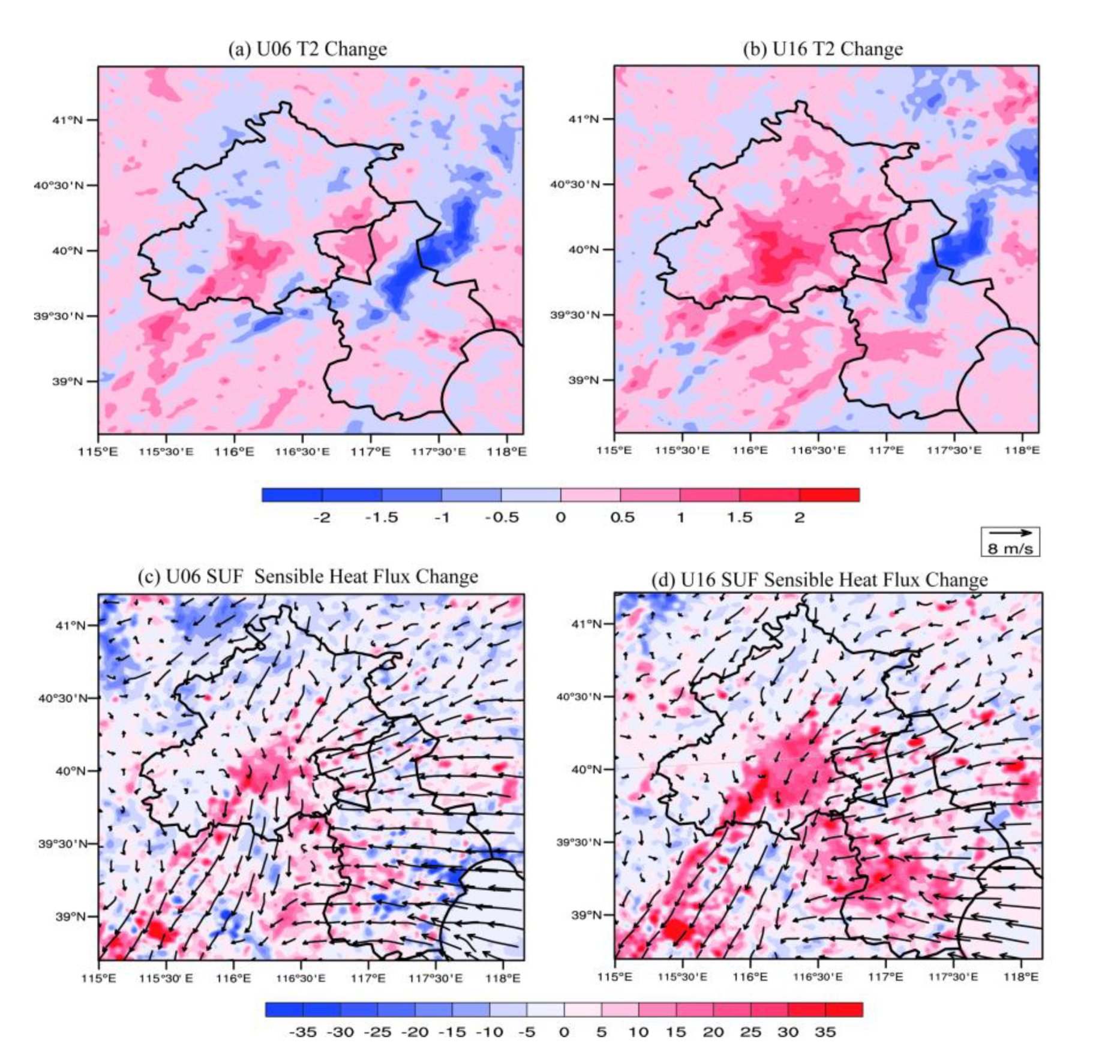

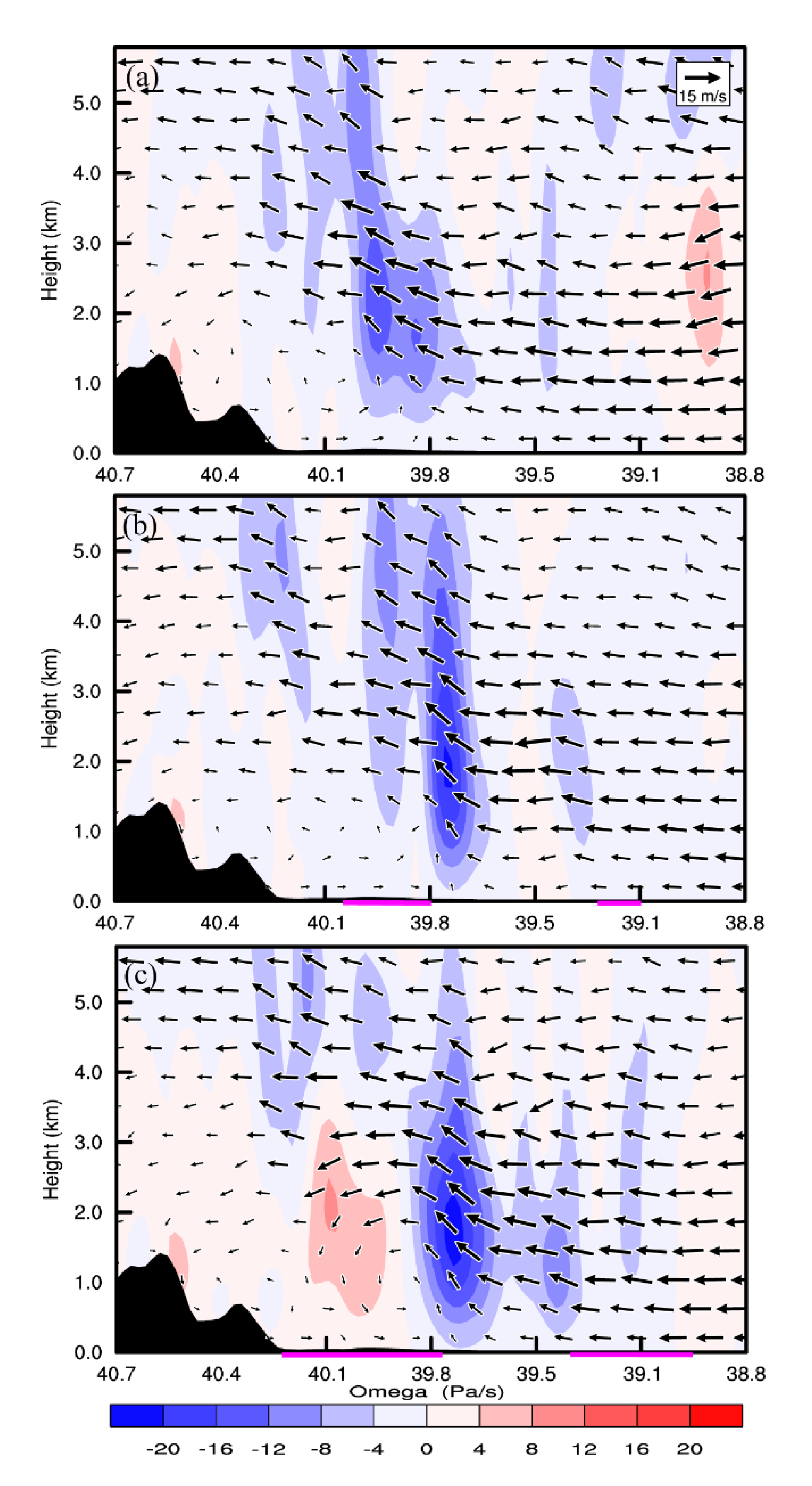
| Model Parameters | D1 | D2 | D3 |
|---|---|---|---|
| Simulated time | 2016-07-19 12:00 UTC to 2016-07-21 00:00 UTC | ||
| Grid interval (km) | 9 km | 3 km | 1 km |
| Horizontal grids | 300 × 300 | 367 × 367 | 367 × 409 |
| PBL | Bougeault–Lacarrere (BouLac) | ||
| Microphysics | Purdue-Lin | ||
| LW radiation | RRTMG | ||
| LSM | Noah LSM + BEP | ||
| Cumulus | Kain–Fritsch | None | |
| Simulation Experiments | Types of Land Use |
|---|---|
| No urban | Replant the the city as farmland |
| Urban 06 | Using 2006 MODIS land-use type data |
| Urban 16 | Using 2016 MODIS land-use type data |
© 2020 by the authors. Licensee MDPI, Basel, Switzerland. This article is an open access article distributed under the terms and conditions of the Creative Commons Attribution (CC BY) license (http://creativecommons.org/licenses/by/4.0/).
Share and Cite
Zhang, J.; Zhou, Y.-s.; Shen, X.-y. Numerical Simulation Analysis of the Impact of Urbanization on an Extreme Precipitation Event over Beijing–Tianjin–Hebei, China. Atmosphere 2020, 11, 945. https://doi.org/10.3390/atmos11090945
Zhang J, Zhou Y-s, Shen X-y. Numerical Simulation Analysis of the Impact of Urbanization on an Extreme Precipitation Event over Beijing–Tianjin–Hebei, China. Atmosphere. 2020; 11(9):945. https://doi.org/10.3390/atmos11090945
Chicago/Turabian StyleZhang, Jing, Yu-shu Zhou, and Xin-yong Shen. 2020. "Numerical Simulation Analysis of the Impact of Urbanization on an Extreme Precipitation Event over Beijing–Tianjin–Hebei, China" Atmosphere 11, no. 9: 945. https://doi.org/10.3390/atmos11090945
APA StyleZhang, J., Zhou, Y.-s., & Shen, X.-y. (2020). Numerical Simulation Analysis of the Impact of Urbanization on an Extreme Precipitation Event over Beijing–Tianjin–Hebei, China. Atmosphere, 11(9), 945. https://doi.org/10.3390/atmos11090945




